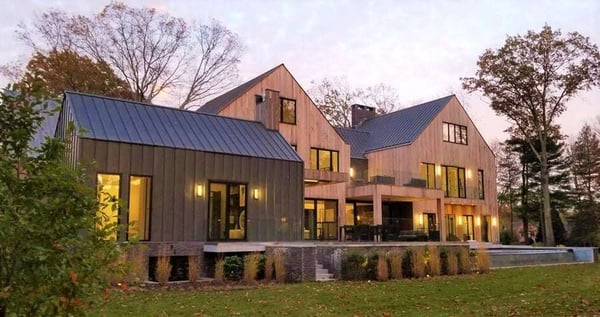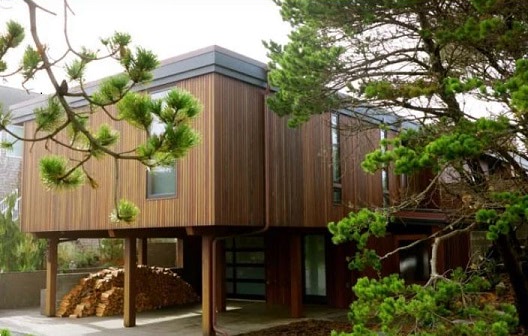Wood rainscreen is an all natural option for both a healthy home and long-lasting siding. But what is it? And why is it a healthy choice? A rainscreen siding system does not just prevent rainwater from getting trapped behind exterior siding. Did you know that a rainscreen also helps manage the moisture within your home? And that’s not all. See how a wood rainscreen offers curb appeal, energy savings, and a healthy home.


Did you know that rainscreen also creates the proper spacing you need in the wall cavity to manage the moisture within your home? A rainscreen system is frequently thought to only be effective in keeping bulk rainwater away from the underlying building exterior. But it does so much more.
Wood rainscreen also gives the benefits of great looks, design options, natural siding, low-maintenance options, and energy savings. What's not to like?

What Is A Wood Rainscreen?
- A rainscreen is a method of spacing the siding away from your home’s weatherproofed exterior (or ‘building envelope’).
- A wood rainscreen is simply a rainscreen system that uses natural wood siding.
- A well designed rainscreen gap allows bulk water to drain out before it affects your home, instead of getting trapped behind your siding.
Browse more beautiful ways to design with wood rainscreen. Download the Featured Rainscreen Projects Portfolio here.
Why Plan For A Healthy Home?
Air flow through your home exterior is essential to your family’s health and well-being. A healthy home should “breathe” to create air exchange without trapping any moisture. This results in healthier air for your family inside your home. It also helps prevents airborne health hazards like mold and mildew from thriving in your living spaces from the exterior.
How does rainscreen accomplish this better than traditional siding? Because rainscreen is placed away from the home exterior it leaves a space, called a ‘rain screen gap’ or ‘wall cavity’, between the building envelope and the siding. This space is crucial for a healthy home design.
Your siding is your home’s first line of defense. It creates a shield against weather. This keeps rain, snow, sleet, and other weather away from your structure.
Besides minimizing the threat of mold and rot, a rainscreen wall cavity design prevents threats to your home such as rot and insect damage.
Here’s how it works.
- Compared to a masonry curtain wall construction, where moisture is nearly trapped in the wall cavity, a proper wood rainscreen uses an open-joint or a ventilated wood siding system.
- The inner wall of your structure is first weatherproofed to keep the weather from entering the interior of the structure (building envelope).
- Then outer siding is attached to keep weather away from the structure, this siding serves as the "rainscreen".
- The gap between the siding and the weatherproof wall allows moisture potentially trapped inside the structure to escape from behind the siding.
Want to know more about how rainscreen siding works? Click here.
What about energy savings?
A properly designed rainscreen wall cavity also provides a passive insulation layer, which saves you money in energy costs. Besides moisture management, the open space between the layers of the rain screen system will create an energy-efficient air space that acts as a passive insulation layer.
This layer helps buffer the transmission of both cold and heat. This efficient management of temperature changes means a better interior climate and less energy expense. (Translation: it keeps the kids away from the thermostat!)
How much does a wood rainscreen cost over time?
You can see how rainscreen helps avoid costly damage to your home exterior. There are substantial additional benefits to using real hardwood siding as part of your rainscreen system.
Choosing a low-maintenance hardwood siding option with reliable species like Ipe, Machiche, Garapa or Cumaru gives your siding a big advantage, and savings:
- No painting.
- No staining. Simply let your siding weather to a gray patina
Want more information on how hardwoods weather
and how they look when they do?
Download the How Woods Weather Guide for free, now.
Hardwoods are so dense they are naturally rot, insect, and water damage resistant. Your siding is safer from damage inside and outside the rainscreen. The natural high density also means your siding is extremely resistant to wear and tear from branches, flying storm debris and Uncle George leaning his patio chair on it at every barbecue!
Hardwood also has the proven benefit or requiring little to no maintenance over decades of use, just add a new coat of UV protectant sealant (we like Penofin Hardwood Formula Penetrating Finish) as needed. This keeps your siding looking like new. Or, if left to weather naturally, you will be rewarded with a gorgeous silver-gray patina that requires only a simple annual cleaning.
Want to know more about how wood siding options for rainscreen?
Download your FREE Ultimate Guide to Rainscreen now.
Ready for more design inspiration using rainscreen? We made a free download for you here.
Featured Rainscreen Project Portfolio
Then view the Rainscreen Siding Photo Gallery, click here.
